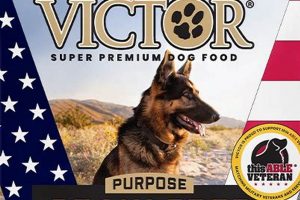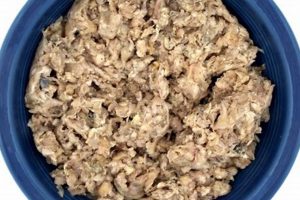Canine diets incorporating dairy-derived solids are available commercially. These products may include processed cheddar or similar variants, aiming to enhance palatability and provide an alternative protein source. An example is a dry kibble formulation containing a percentage of dehydrated cheese powder to encourage consumption in picky eaters.
The incorporation of dairy solids in pet food can offer advantages such as increased palatability, potentially promoting better food intake, particularly in animals with reduced appetites. Historically, dairy products have been included in animal diets as a source of nutrients and to improve the overall sensory experience of the food. However, considerations regarding lactose intolerance in some canines and the overall nutritional profile of the product are critical.
The following sections will delve into the nutritional composition of these formulations, potential health implications, and guidelines for responsible usage. Specific attention will be paid to the suitability of these products for various breeds, ages, and health conditions within the canine population.
Guidance on Dairy-Enriched Canine Nutrition
The following outlines key considerations for the responsible inclusion of dairy-derived components in canine diets. Implementing these guidelines can assist owners in making informed decisions regarding the nutritional needs of their animals.
Tip 1: Assess Lactose Tolerance. Prior to introducing any product containing dairy, observe the canine for signs of lactose intolerance, such as diarrhea or gastrointestinal distress. Begin with small quantities to gauge individual sensitivity.
Tip 2: Evaluate Nutritional Content. Scrutinize the product’s nutritional label to ensure a balanced profile. The product should complement, not replace, a complete and balanced primary food source. Pay particular attention to the fat and sodium content.
Tip 3: Consider Underlying Health Conditions. Canines with pre-existing conditions, such as pancreatitis or kidney disease, may require dietary restrictions that preclude the inclusion of dairy. Consult with a veterinary professional before introducing new products.
Tip 4: Moderate Portion Sizes. Dairy-containing products should be treated as supplemental additions, not meal replacements. Excess consumption can contribute to weight gain and digestive upset.
Tip 5: Choose Reputable Brands. Select products from established manufacturers with transparent sourcing and quality control measures. Prioritize formulations specifically designed for canine consumption to ensure safety and efficacy.
Tip 6: Observe for Allergic Reactions. Monitor for signs of allergic reaction, such as skin irritation, itching, or swelling. Discontinue use and consult a veterinarian if any adverse reactions are observed.
Adherence to these guidelines facilitates a responsible and informed approach to incorporating dairy components into a canine’s diet. Emphasis should remain on providing a balanced and nutritionally complete food source tailored to the individual animal’s needs.
The subsequent sections will further explore the specific applications and potential limitations of dairy-inclusive canine nutrition.
1. Palatability Enhancement
The incorporation of dairy flavors and aromas into canine diets aims to improve acceptance and consumption of food. This strategy is particularly relevant for animals exhibiting reduced appetites or those with specific dietary needs where consistent intake is crucial.
- Sensory Appeal
Dairy-derived compounds, such as volatile fatty acids and amino acids, contribute to olfactory and gustatory stimuli that can increase a dog’s interest in food. The presence of these sensory cues may overcome neophobia or food aversion, encouraging consumption.
- Texture Modification
Dairy ingredients can alter the texture of dry or wet food, creating a more appealing mouthfeel. Powders or solids blended into kibble can increase surface area and porosity, affecting the release of flavor compounds during mastication.
- Masking Undesirable Flavors
Dairy flavors can effectively mask less palatable ingredients, such as certain medications or supplemental nutrients. This masking effect can be particularly useful in ensuring compliance with prescribed dietary regimens.
- Enhanced Digestibility Perception
The presence of dairy, although not directly impacting digestibility for all dogs, may create a perception of higher nutrient availability. This psychological effect can further stimulate appetite and increase food intake.
While dairy additions enhance palatability, careful consideration must be given to individual canine tolerances and potential allergic reactions. The goal is to improve food acceptance without compromising nutritional balance or digestive health. The selection of high-quality ingredients and careful portion control are essential for successful implementation.
2. Lactose Intolerance Risks
The presence of lactose in dairy products incorporated into canine diets introduces the risk of lactose intolerance. Canines, particularly after puppyhood, often exhibit reduced lactase production, the enzyme necessary for breaking down lactose. Consequently, the ingestion of lactose can lead to undigested lactose reaching the large intestine, where it is fermented by bacteria, resulting in gas production, bloating, diarrhea, and abdominal discomfort. The severity of these symptoms varies depending on the amount of lactose consumed and the individual dog’s lactase activity. The inclusion of hard cheeses, which naturally contain lower lactose levels due to the cheese-making process, may mitigate, but does not eliminate, this risk.
The potential for gastrointestinal distress underscores the importance of careful observation following the introduction of dairy-inclusive products. For instance, a small breed dog with a sensitive digestive system may exhibit pronounced symptoms after consuming a relatively small quantity, whereas a larger breed may tolerate a slightly higher dose without noticeable adverse effects. It is crucial to recognize that even if a dog does not exhibit immediate or severe symptoms, repeated exposure to lactose over time can contribute to chronic digestive issues. Furthermore, lactose intolerance can exacerbate existing gastrointestinal conditions, potentially complicating treatment and management.
In conclusion, the risk of lactose intolerance represents a significant consideration when evaluating the suitability of dairy-containing products for canines. Vigilant monitoring, portion control, and a thorough understanding of the individual animal’s digestive sensitivities are essential for minimizing the potential for adverse health outcomes. Alternative formulations with reduced lactose content or complete lactose removal may offer a safer and more palatable option for lactose-intolerant canines, thereby reducing the risk of digestive upset and promoting optimal health.
3. Nutritional Imbalance Potential
The introduction of cheese into canine diets carries the inherent risk of creating nutritional imbalances. While cheese offers protein and certain micronutrients, its disproportionate fat and sodium content, relative to other essential nutrients, can disrupt the carefully formulated balance in commercial dog foods. A primary concern arises from the potential for excessive caloric intake due to the high fat concentration in many cheeses. This surplus of calories, if not properly balanced with increased physical activity, contributes to weight gain and subsequent obesity, predisposing canines to a range of metabolic disorders such as diabetes mellitus and cardiovascular disease.
Furthermore, the elevated sodium levels present in processed cheeses can exacerbate pre-existing renal conditions or contribute to the development of hypertension, particularly in sodium-sensitive breeds or geriatric animals. The addition of cheese as a dietary supplement should be carefully considered within the context of the dog’s overall nutritional requirements, paying close attention to the proportions of protein, carbohydrates, fats, vitamins, and minerals. A diet excessively reliant on cheese risks diluting the concentration of other essential nutrients, potentially leading to deficiencies in vitamins, trace minerals, or essential amino acids. For example, replacing a significant portion of a balanced kibble diet with cheese could lead to a reduction in fiber intake, affecting digestive regularity.
In conclusion, the nutritional imbalance potential associated with incorporating cheese into canine diets underscores the critical importance of moderation and informed decision-making. While cheese may offer palatability advantages, its nutritional profile necessitates careful consideration to avoid disrupting the delicate balance of essential nutrients, mitigating the risk of weight gain, metabolic disorders, and specific nutrient deficiencies. Consultation with a veterinary nutritionist is advisable to determine the appropriate inclusion of cheese within a balanced and complete dietary regimen, ensuring optimal health and well-being.
4. Allergenic Concerns
The inclusion of dairy products, specifically cheese, in canine diets introduces the potential for allergic reactions. The primary allergenic components in cheese are milk proteins, such as casein and whey. Canines with sensitivities to these proteins may exhibit a range of adverse reactions following ingestion, ranging from mild dermatological symptoms to severe gastrointestinal distress. The allergenic response is triggered by the immune system’s misidentification of these proteins as harmful substances, leading to the release of inflammatory mediators and the subsequent manifestation of clinical signs. Real-world examples include cases of dogs developing pruritus (itching), urticaria (hives), or even facial swelling after consuming cheese-containing foods. The recognition of these potential reactions is crucial for responsible pet ownership.
The practical significance of understanding the allergenic potential of cheese dog food lies in the ability to proactively manage dietary risks. Diagnostic testing, such as serum allergy tests or elimination diets, can assist in identifying specific protein sensitivities. Upon confirmation of a dairy allergy, strict avoidance of cheese and other dairy-containing ingredients becomes paramount. Alternative protein sources and specialized hypoallergenic diets formulated without milk proteins offer viable solutions for maintaining canine health and well-being. Furthermore, careful scrutiny of ingredient labels on commercial dog foods is essential to ensure the absence of hidden dairy components. The manufacturing processes of some dog food brands may lead to cross-contamination, even in products not explicitly labeled as containing dairy.
In summary, allergenic concerns represent a critical aspect of evaluating the suitability of cheese dog food for individual canines. Recognizing the potential for adverse immune responses to milk proteins, employing diagnostic testing when indicated, and implementing strict dietary management strategies are essential steps in mitigating allergy-related risks. Challenges remain in accurately identifying and managing canine food allergies, emphasizing the need for collaboration between pet owners and veterinary professionals. A comprehensive understanding of allergenic concerns within the broader context of canine nutrition contributes to improved pet health outcomes and responsible pet care practices.
5. Product Quality Variances
Substantial variations exist in the quality of products marketed as “cheese dog food.” This variability stems from differences in ingredient sourcing, manufacturing processes, and adherence to quality control standards. These variances directly impact the nutritional value, safety, and overall suitability of these products for canine consumption.
- Cheese Source and Composition
The origin and type of cheese used significantly affect product quality. Some formulations incorporate real cheese, while others rely on artificial cheese flavorings or by-products. Real cheese varies in fat content, sodium levels, and the presence of additives. Inferior products may utilize low-quality cheese sources with excessive sodium or undisclosed additives, potentially harming canine health.
- Manufacturing Standards and Processes
Divergences in manufacturing protocols influence product safety and nutritional integrity. Reputable manufacturers adhere to stringent quality control measures, including testing for contaminants and accurate nutrient profiling. Less scrupulous producers may lack these safeguards, increasing the risk of bacterial contamination, mycotoxin presence, or nutrient imbalances. Improper handling during processing can degrade the nutritional value of the cheese and other ingredients.
- Ingredient Transparency and Labeling Accuracy
The clarity and accuracy of ingredient labeling are critical indicators of product quality. High-quality products provide detailed information about the cheese source and composition, as well as the percentage of cheese included in the formulation. Substandard products may employ vague or misleading labeling practices, concealing the true nature of the ingredients and their proportions. Inaccurate labeling can hinder informed decision-making by pet owners.
- Nutritional Completeness and Balance
The overall nutritional profile of “cheese dog food” products varies widely. Superior formulations are designed to complement a complete and balanced diet, providing supplemental nutrients or palatability enhancement without disrupting the canine’s nutritional needs. Inferior products may lack essential nutrients or contain excessive levels of fat or sodium, potentially contributing to health problems over time.
These interconnected factors underscore the importance of careful product evaluation. Pet owners should prioritize products from reputable manufacturers with transparent sourcing practices, detailed ingredient information, and comprehensive nutritional profiling. Selecting high-quality “cheese dog food” options minimizes the risk of adverse health outcomes and promotes the well-being of the animal.
Frequently Asked Questions About Cheese Dog Food
The following addresses common inquiries regarding the use of cheese in canine diets, focusing on nutritional aspects, potential risks, and best practices. This information is intended to provide clarity and promote informed decision-making concerning the integration of these products.
Question 1: Is cheese dog food a nutritionally complete meal?
No, products described as “cheese dog food” are generally not formulated to provide complete and balanced nutrition for canines. They typically serve as supplemental additions to a primary diet, rather than meal replacements. Reliance solely on these products can lead to nutritional deficiencies.
Question 2: What are the primary risks associated with feeding cheese to dogs?
The main risks include lactose intolerance, which can cause gastrointestinal distress; high fat content, potentially leading to weight gain and pancreatitis; and elevated sodium levels, posing concerns for canines with kidney or heart conditions. Additionally, some dogs may exhibit allergic reactions to milk proteins.
Question 3: How much cheese is safe for a dog to consume?
The appropriate quantity varies depending on the size, breed, and health status of the dog. Cheese should be offered sparingly as a treat, typically constituting no more than 10% of the daily caloric intake. Monitoring the dog for any adverse reactions is essential.
Question 4: Are some types of cheese safer for dogs than others?
Hard cheeses, such as cheddar or Swiss, generally contain lower levels of lactose compared to softer varieties. This may reduce the risk of lactose intolerance. However, all types of cheese should be given in moderation due to their fat and sodium content.
Question 5: Can cheese be used to administer medication to dogs?
While cheese can be used to conceal medication, this practice should be approached with caution. Ensure the cheese does not interact negatively with the medication. If the dog refuses the cheese-encased medication, seek alternative methods to administer the drug.
Question 6: What are the signs of a dairy allergy in dogs?
Signs of a dairy allergy may include skin irritation (itching, redness, hives), gastrointestinal upset (vomiting, diarrhea), ear infections, or respiratory problems. If any of these symptoms are observed after cheese consumption, discontinue use and consult a veterinarian.
In summary, cheese can be incorporated into a canine’s diet in moderation, provided that potential risks are understood and appropriate precautions are taken. A balanced approach, prioritizing the dog’s overall health and nutritional needs, is paramount.
The concluding section will summarize the key considerations discussed and offer final recommendations regarding cheese dog food.
Conclusion
This exploration of “cheese dog food” has illuminated the multifaceted considerations surrounding its use in canine diets. Key points encompass the potential for palatability enhancement, the risks associated with lactose intolerance and allergenic reactions, the nutritional imbalance potential, and the significant variations in product quality. The judicious inclusion of cheese requires a thorough understanding of these factors, tailored to the individual dog’s specific health needs and dietary requirements.
Ultimately, the responsible provision of canine nutrition demands careful evaluation and informed choices. Further research into the long-term effects of dairy inclusion, coupled with stringent quality control standards within the pet food industry, is essential to ensure the safety and well-being of canine companions. Prioritizing a balanced and complete diet, in consultation with a veterinary professional, remains the cornerstone of optimal canine health.







